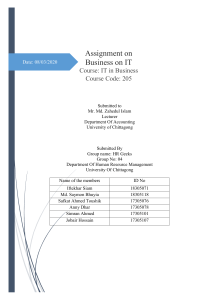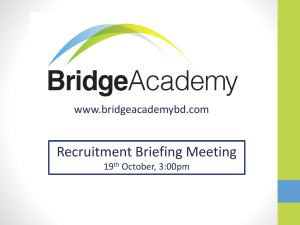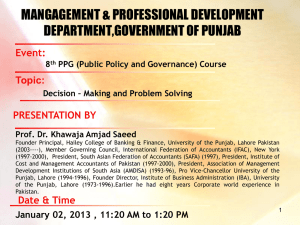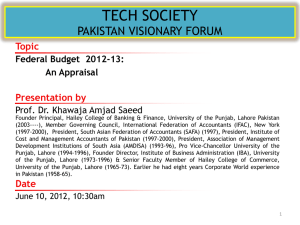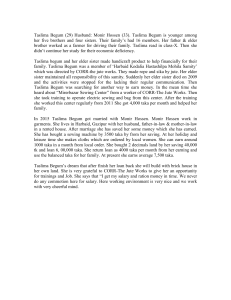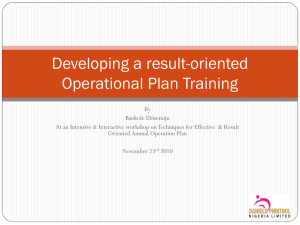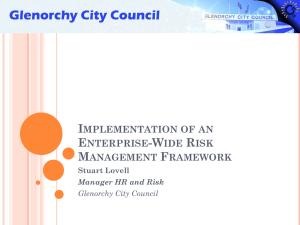Corporate-Lending-Risk-Analysis
advertisement
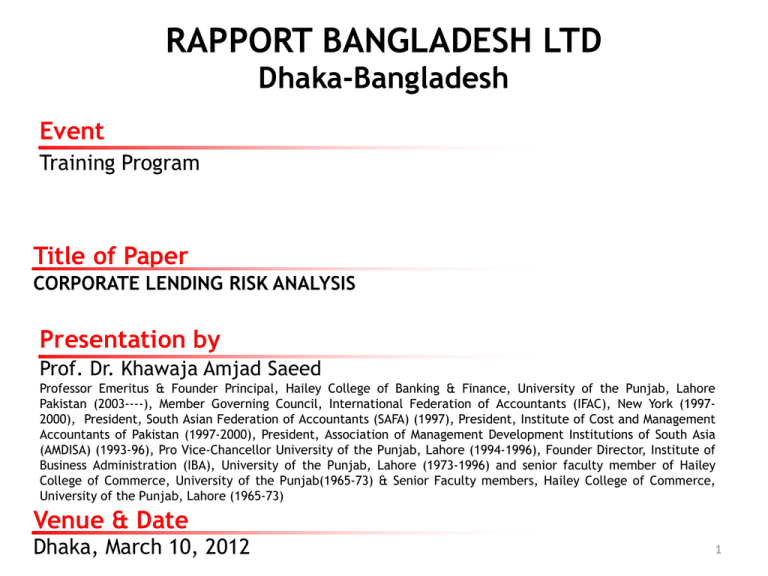
RAPPORT BANGLADESH LTD Dhaka-Bangladesh Event Training Program Title of Paper CORPORATE LENDING RISK ANALYSIS Presentation by Prof. Dr. Khawaja Amjad Saeed Professor Emeritus & Founder Principal, Hailey College of Banking & Finance, University of the Punjab, Lahore Pakistan (2003----), Member Governing Council, International Federation of Accountants (IFAC), New York (19972000), President, South Asian Federation of Accountants (SAFA) (1997), President, Institute of Cost and Management Accountants of Pakistan (1997-2000), President, Association of Management Development Institutions of South Asia (AMDISA) (1993-96), Pro Vice-Chancellor University of the Punjab, Lahore (1994-1996), Founder Director, Institute of Business Administration (IBA), University of the Punjab, Lahore (1973-1996) and senior faculty member of Hailey College of Commerce, University of the Punjab(1965-73) & Senior Faculty members, Hailey College of Commerce, University of the Punjab, Lahore (1965-73) Venue & Date Dhaka, March 10, 2012 1 PRESENTATION FRAME Section A: 1. Risk: Concept Characteristics Categories Types 2. Risk Management Model: RMMM 3. Risk Assessment: Environment Management Approach Organizational Analysis 4. Risk Mitigation: Characteristics of Successful Banks Mission Statement Market Research Innovation 2 PRESENTATION FRAME 5. Seven Cs Analysis: Risk Evaluation 6. NIB: Lending Models in Pakistan 7. Projects Risks: Risks Safeguarding Against Project Cost Over Runs Project Profile Section B: Workshop Exercise, Problem Solving Session and Case Analysis 1. Risk Assessment: Sensitivity Analysis 2. Financial Analysis Exercise 3. Case Study SECTION: A A-1: RISK Concept: 1. Loss of part or all of the actual. 2. Lower Yield on an investment than expected. 3. “While it is futile to try to eliminate risk and questionable to try to misuse it; it is essential that the risks taken be the right risks” (Peter Drucker). Characteristics: 1. Uncertainly: May or may not happen. 2. Loss: If the risk becomes a reality, losses will occur. 4 A-1: RISK Categories 1. Known: 2. Predictable: 3. Unpredictable: Can be uncovered after: a. Careful evaluation of the project plan. b. Reliable information sources: • Lack of documented requirements. • Unrealistic project plans. Extrapolated from past project experience . Can occur but are difficult to identify in advance. 5 A-1: RISK Types - Specific - Project Risks: - Budget - Schedules - Personnel - Resource - Customers - Technical Risks: - Design - Implementation - Verification - Maintenance - Market Risk - Management Risk 6 A-2: RISK MANAGEMENT MODEL RMMM 1. 2. 3. Risk Mitigation Risk Monitoring Risk Management 7 A-3: RISK ASSESSMENT ENVIRONMENT A: Traditional 1. Internal (4): - Revenue - Expenditure - Finances - Human Resources 2. External (4): - PEST B: Current: Task Orientation 1. Competition 2. Customers 3. Suppliers 4. Distribution Channels 8 A-3: RISK ASSESSMENT MANAGEMENT APPROACH 1. Management Controls 1. Vision 2. Mission 3. Objectives 4. Organization 2. Marketing 1. Market Research (+Tools) 2. Sales Trends 3. Sales Promotion 4. Sales Training 5. Sales Controls 6. Sales Force 7. Competition 8. Product (s) 9. Pricing 10. Distribution 9 A-3: RISK ASSESSMENT MANAGEMENT APPROACH 3. Manufacturing 1. Plant 2. Equipment & Facilities 3. Plant Operations 4. Production Planning 1. Purchasing 2. Material Controls 3. Production Planning & Control 4. Quality 5. Cost Control 5. Industrial Relations 1 +PR 6. Legal 10 A-3: RISK ASSESSMENT ORGANIZATIONAL ANALYSIS Focus 1. 2. 3. Aspects 1. 2. 3. 4. 5. 6. 7. 8. Customers Performance People - Enthusiastic Financial Inspired Foundation Customer Goals Approach - Technology Act People Lead - Strong Special Bold Simplify, Simplify & Simplify Your Servant Fast Unleash the Power With Care 11 A-4: RISK MITIGATION CHARACTERTICS OF SUCCESSFUL BANKS 1. Culture 2. Values 3. Performance 4. Orientation 5. Products 6. Leadership 7. Recruitment 8. Investment 9. MIS 10. Credit Process : : : : : : : : : : Open Strong and Shared Profit Customers Investment in New Strong and Consistent The Best Persons In Training and Career Development Operational Strong and Balanced 12 A-4: RISK MITIGATION MISSION STATEMENT Clear and Concise Statement of: 1. Who we are 2. What we Produce/Serve 3. Market we Serve 4. Philosophical Concerns 5. L.T Objectives 6. Being: Result Oriented Specific Attainable 13 A-4: RISK MITIGATION: MARKET RESEARCH 1. Total Market: 1. Increase 2. How Much: - At home - Abroad 2. Share of Market: 1. Maintain 2. Increase 3. Customers: Present & Potential: 1. Continue to buy 2. Who are they 3. Where are they 4. Who takes what 5. Will they continue to need our products or service 6. What do they use these for 7. Competition 8. Obsolescence 14 A-4: Risk Mitigation: INNOVATION 1. 2. 3. 4. Product Process Function Inter-Departmental 15 A-5: SEVEN (7) Cs ANALYSIS: 1. One “C” - Collateral 2. Three “Cs” - Collateral - Capacity - Condition 3. Five “Cs” 1. 1-3 of 2 above 4. Capital 5. Character 4. Seven “Cs” 1. 1-5 of 3 above 6. Country Risk 7. Currency Risk Risk Evaluation 16 A-6: NIB: LENDING MODES IN PAKISTAN Focus Modes A: Lending (2) 1. Service Charge 2. Qarde Hasna B: Trade Related (6) 1. Mark up 2. Purchase of movable or immovable Property with buy back agreement or otherwise 3. Purchase of trade bills 4. Hire purchase 5. Leasing 6. Development charges C: Investment (4) 1. 2. 3. Total 12 4. Musharka or profit and loss sharing Equity participation PTC and Modarba Certificate Sharing Rent Sharing 17 A-7: PROJECTS: RISKS I: Institutional Factors (10) 1. Final Engineering 2. Concluding Contracts with Consultants 3. Acquiring Right of Way 4. Utilities 5. Procurement Speed of Equipment 6. Funds diverted to other projects 7. Management Consultant Problems 8. Inadequate Supervision 9. Shortage of Local Funds 18 A-7: PROJECTS: RISKS II: Technical Factors (7) 1. Uncertainty of Original Engineering Estimates 2. Conservative Engineering Estimates 3. Unforeseen technical problems (Soil, slides, water ----) 4. Faulty Design 5. Inefficient Contractors 6. Disputes & Claims of contractors 7. Change in Specifications (Additional work-----) III: Economic & Political Factors (3) 1. Change in Project Composition 2. Price Increase 3. Labour Shortages & Disputes Total 20 19 A-7: PROJECT RISKS SAFEGUARDING AGAINST PROJECT COST OVER RUNS 1. 2. 3. 4. Consultants-Careful Selection Consultants-Be Experts and Cost Estimators Contingency Allowance-realistic Estimates Reduce Contractors Fears (Risks) by Proper Explanations in Bidding Documents 5. Supervision of Site-Sound 20 A-7: RISK MITIGATION: PROJECT PROFILE 1. Name and Brief Description 2. Criteria 1. Importance to economy 2. Operationalability 3. Viable Results 4. Size 3. Promoters 1. Names 2. Addresses 3. Financial Position 4. Investment 1. Cost 2. FX 21 A-7: RISK MITIGATION: PROJECT PROFILE 5. Available Finances 1. Amount 2. Terms & Conditions 3. Sources 6. Preliminary Assessment 1. Executing Agency 2. Inputs 3. Water Supply 4. Labour Situation 5. Management 6. Production Methods 22 A-7: RISK MITIGATION: PROJECT PROFILE 7. Amount Needed 1. Form 2. Amount 3. FX 4. Timing of Utilization 8. Information 1. Sources 9. Remarks 1. Regional Head 2. Aspects: Financial Status Technical Acumen General Reputation of Applicant Feasibility Marketability of Products 23 SECTION B B-1: RISK ASSESSMENT: SENSITIVITY ANALYSIS Given Data: Taka. 000 1. Estimated Investment (Taka) 1,000 2. Desired Rate of Return (%) 20 3. Estimated Units Contributing Normal Value (Number)500 4. Estimated Variable Cost (Taka) 1,000 5. Estimated Fixed Cost (Taka) 800 6. Estimated Revenue at Prevailing Price (Taka) 2,000 Required: 1. Visualize several, at least, three sensitivities. 2. Quantify the factors at (1) above. 3. Compute the impact of all the three sensitivity factors. 4. Offer your comments to assess operational risk. 24 B-2: FINANCIAL ANALYSIS EXERCISE 1. Nijat Hussain & Co. Ltd has approached you for financial assistance. 2. Three years balance sheets and income statements figures have been made available to you. 3. Required: a. Undertake trend analysis of time series to develop a perspective b. Develop initial thoughts as to what financial policies the company is following in respect of: Resource Mobilization Resource Utilization Protection of Financial Resources: Risks which the company is facing Financial Management Problems 25 Distribution in Terms of Dividends B-2: FINANCIAL ANALYSIS EXERCISE 5. Having built a perspective, undertake financial analysis exercise by computing various ratios: a. Liquidity b. Solvency c. Profitability 6. Prepare credit appraisal report. Write up for discussion is enclosed. 26 B-3: CASE STUDY: Bank’s Role: Managerial: Doubling the Profit Jauhar Brothers, manufacturers of all metal garden and porch furniture, presented their operating statement as of June 30, 2011 the result of six months operations. Sales TAKA Taka 525,000 Cost of Goods Sold: Variable Expenses: Materials 52,500 Labour 70,750 Superintendence 21,000 Heat, Light, Power 5,250 Rs. 149,500 27 B-3: CASE STUDY: Bank’s Role: Managerial: Doubling the Profit Fixed Expenses: Superintendence 9,000 Heat, Light, Power 3,000 Depreciation Repairs to Building Cost of Goods Sold 6,000 7,500 25,500 175,000 Gross Profit 350,000 Selling and Administrative Expenses: Variable Expenses: Commission Advertising 105,000 5,250 110,250 Fixed Expenses: Officers Salaries 30,000 Advertising 30,000 Office Salaries Miscellaneous Expenses Total Selling and Administrative Expenses Net profit 72,000 30,000 162,000 Taka 272,250 77,750 B-3: CASE STUDY: Bank’s Role: Managerial: Doubling the Profit Based on discussions held, it transpired that the above enterprise was operating at 60% of its installed capacity. However based on marketing survey carried out, it was concluded that the enterprise has good market potential which could be tapped by increasing its capacity to 85%. Accordingly the bank has been approached to finance the expansion plan which will result in almost doubling the profit. Required: The enterprise seeks your guidance in respect of management decisions to be taken to meet the challenge to raise the capacity from 60% to 85%. With ensequential benefits. Suggest a sound managerial plan to achieve the above goal so that the bank can then guide the enterprise to achieve desired results and also pave the way to finance expanding needs. 29 B-3: CASE STUDY 1. Guidelines for developing a managerial decision plan to raise the capacity from 60% to 80% are suggested below: 1. Sales: - Assume a constant price. - Can suggest others also. 2. Labour: - Suggest some percentage of sales: 15%. - This will serve as motivational. 3. Superintendence: - Variable: suggest some percentage: 3%. - Fixed suggest some increase: Taka: 8,250. 4. Advertising: - Present fixed and variable amounts are adequate for all volume upto 60%. 30 - Variable rate may be 5% of such increase. B-3: CASE STUDY 5. Others: - All other variable rates will keep their same relationship. Required: 1. Compute the effect on: a. Overall profitability results b. Break even point Hint Formula: FC BEP= ---------------------VC 1- ----------TR 2. Also undertake stakeholders beneficial impact. 31 32
